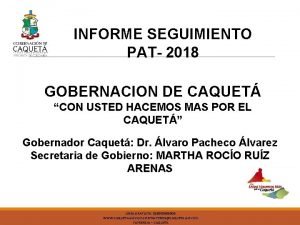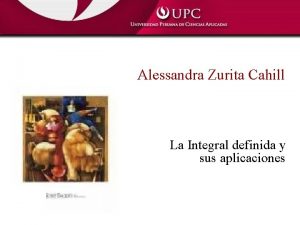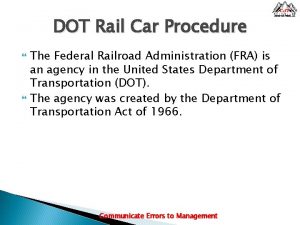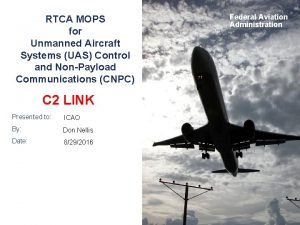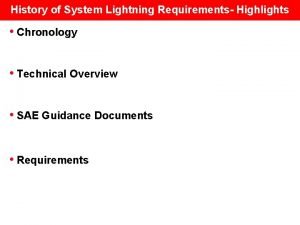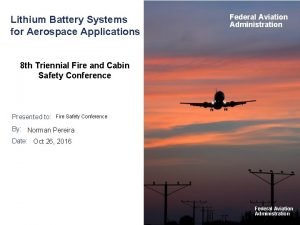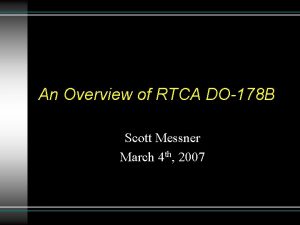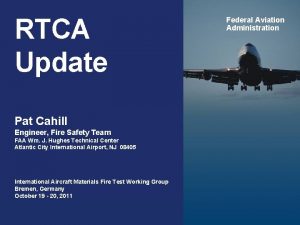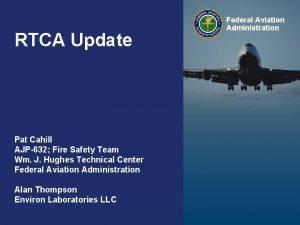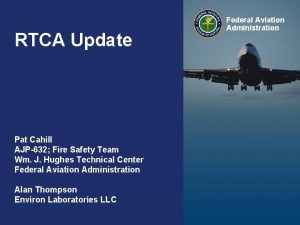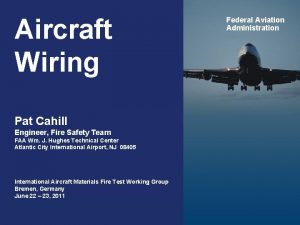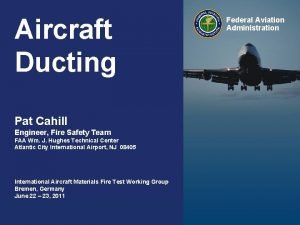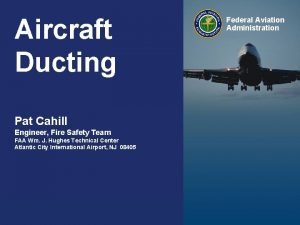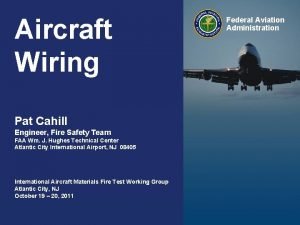RTCA Update Federal Aviation Administration Pat Cahill Engineer









- Slides: 9

RTCA Update Federal Aviation Administration Pat Cahill Engineer, Fire Safety Team FAA Wm. J. Hughes Technical Center Atlantic City International Airport, NJ 08405 International Aircraft Materials Fire Test Working Group Bremen, Germany June 22 – 23, 2011 RTCA Update Federal Aviation Administration

Commercial Aircraft Electronics (Avionics) • RTCA, Inc. − Not-for-Profit corporation that functions as a Federal Advisory Committee − Dozens of “Special Committees” working with oversight from a Program Management Committee, and input from the FAA RTCA Update Federal Aviation Administration 1

Background (A Review) • Advisory circular (AC 2116 F) identifies RTCA Doc. No. (RTCA/DO)-160 F as an acceptable means of environmental qualifications for showing compliance with airworthiness requirements. • This AC excludes Section 26, “Fire and Flammability” as it is not as stringent as FAA accepted methods. RTCA Update Table 26 -2 Type of Test Determination Method Components Paragra ph All materials other than rubber or elastomer parts, wire and cable Vertical 12 second bunsen burner test 26. 7. 2 Rubber or elastomer parts Horizontal bunsen burner test 26. 7. 3 Wire and cable 60 degree bunsen burner test 26. 7. 4 - Methods verbatim from Fire Test Handbook Federal Aviation Administration 2

Section 26 changed: • Focus on current industry accepted method, FAR Part 25 (Fire test Handbook) • Define configurations that should be exempt from testing and which configurations should be tested • Clearly define what meets “small electrical components” in the small parts exemption criteria • Define how to approach sample size (raw material is often not available, use actual hardware? ) RTCA Update Federal Aviation Administration 3

Small Parts Exemption: Parts/materials which are considered small may be exempt due to their small size and amount because they would not contribute significantly to the propagation of a fire. Examples of small parts could be: knobs, handles, rollers, fasteners, clips, grommets, rub strips, pulleys, etc. Further definition is offered below: Size Relation (Typical Usage) Fits inside a 76. 2 mm x 12. 7 mm (3” x. 5”) or 50. 8 mm x 50. 8 mm (2” x 2”) Box without bending of the part Smaller than 50. 8 mm x 76. 2 mm x 1. 178 mm (label and / or its adhesive) (2” x 3” x. 07”) Smaller than 6. 35 mm (0. 25”) Dia. Sphere (drop of thread lock or Nycote) Smaller than 101. 6 mm x 2. 286 mm (4” x. 09”) dia (lacing tape) Consideration must be given when more than one small part is located in the same proximity with other small parts (one part may ignite the other part) as the combined fuel load may contribute to propagation of a flame, in this case the above small parts exemption would not apply. Small parts exemption does not apply to wire and cable. RTCA Update Federal Aviation Administration

Where are things now? • No recent updates. • Document is still being reviewed and awaiting approval. RTCA Update Federal Aviation Administration 5

Assuming Rev G is accepted … where do we go from here? RTCA Update Federal Aviation Administration

Test the box whole Advantages: • Does not require breakdown and analysis of individual components • Only one test would be required (multiple burns may be required on same unit based on internal fuel load) • If flame cannot stay lit (enclosure does not allow sufficient air for combustion) unit passes • If combustion of internal components does occur, data can include observations for smoke and external flame (useful? ) RTCA Update Federal Aviation Administration 7

ANSI T 1. 319 One possible test method … The SC-135, which is the environmental testing, the product is DO-160 Rev G. The revision cycle time has changed from 3 to 5 years. RTCA Update Federal Aviation Administration 8

